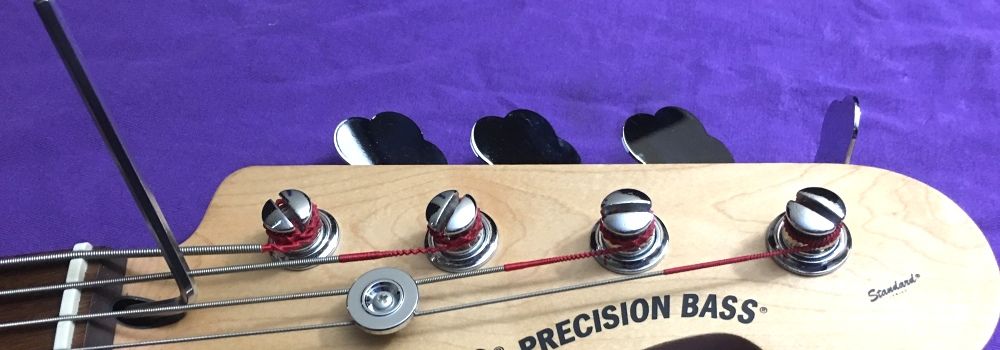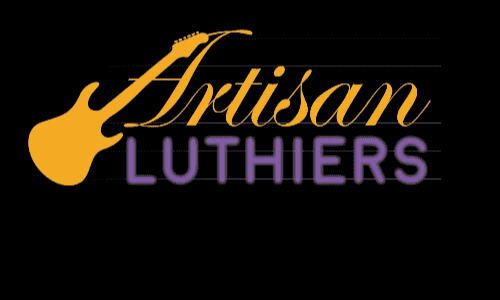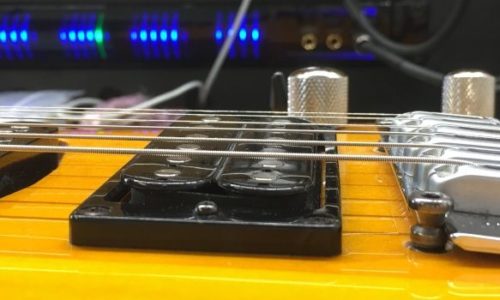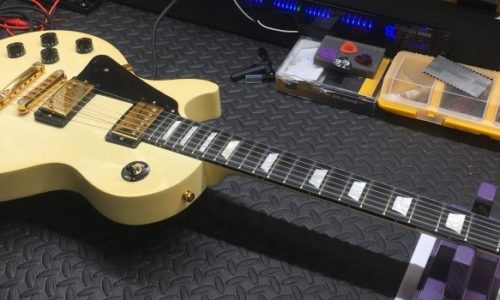Guitar Truss Rod Adjustment Guide

Guitar Truss Rod Adjustment Guide
This article provides a top-level view of how a truss rod works and how to adjust a truss rod. Adjusting a guitar truss rod is a key part of maintaining optimal playability.
Understanding Your Truss Rod
BEFORE YOU DO ANYTHING TO YOUR TRUSS ROD you need to have a reasonably good understanding of truss rods. Don’t laugh this off. You’re dealing with an engineered system and need to understand truss rod design and how a truss rod works.
All guitar truss rods are alike only with regards to their intended function, to adjust neck relief. All truss rods are made of steel, however; the composition of the steel used is not the same. The variances in steel composition, rod diameter, and manufacturing quality result in wide differences in the strength of any truss rod.
Why does truss rod strength matter? When adjusting a truss rod, in either direction, you are changing the force applied to the rod. The types of forces that act on a truss rod are compression, tension, and torque.
Loosening a truss rod (turning counter-clockwise) adds relief to (decreases tension on) the neck which results in increased (higher) string action height. Loosening the truss rod is done to correct backbow.
Tightening a truss rod (turning clockwise) increases compression, thereby pushing the center of the neck toward the strings. The MusicPlayers.com website describes it in this manner, “This straightens an up-bowed neck, pulling the peghead away from the tension of the strings. This reduces relief, lowering the string action (height of the strings over the frets). Turn the nut clockwise to tighten the rod.”1 Tightening the truss rod is done to correct upbow.
What happens if you overtighten a truss rod? As you overtighten a truss rod you move toward applying more force than it can tolerate. This force effectively becomes torque that shears (twists off / breaks) the rod or the adjustment nut. Most broken truss rods can be repaired, however; the cost to repair a broken truss rod is often more than the value of the guitar. The cost to replace a guitar truss rod is usually between $400 to $700, depending upon the type of guitar and where you live. A possible repair option is to buy a replacement but this is not cheap and brings yet another set of issues.
How many types of guitar truss rods are there? There are many types of truss rods for acoustic and electric guitars. European luthier Marguerite Pastella, of Fret Not Guitar Repair, identified five types of truss rods commonly used in building electric and acoustic guitars.2
For this article we’re going to disucss the two most common types of truss rods used for electric guitars and bass guitars. The two common truss rods are a Single Action Truss Rod and a Dual Action Truss Rod.
Single Action Truss Rod
Single-action truss rods are the most common truss rod in commercially manufactured instruments. These rods are designed to be tightened, thereby increasing pressure on the back of the neck. This results in the neck being forced to bow backward. The purpose of this is generally to counteract the tension of the strings to straighten the neck.
Dual Action Truss Rod
A dual-action, aka double-action, truss rod enables you to make neck adjustments in both directions (up or down). Uniquely, dual-action truss rods can create relief with or without string tension. Two-way truss rods have adjustment points (nuts) at each end.
Single Action Truss Rod vs. Dual Action Truss Rod
Which Way Do You Turn a Truss Rod
Which way you turn a truss rod depends on the desired effect. Before tightening your truss rod it’s always a good idea to give it a short counter-clockwise turn to loosen it. To do a professional guitar setup or professional bass setup you want the neck to be level (flat). To compensate for undesirable curvature in the neck you can adjust your neck up or down.
Decrease Relief Tightening the truss rod by turning it clockwise influences the neck to curve upward toward the strings (convex).
Increase Relief Loosening the truss rod by turning it counter-clockwise influences the neck to pull away from the strings (concave).
Checking Relief
Check the amount of relief throughout your adjustment process. Start with a neck relief check to get an idea of how much adjusting is required. An important thing to note is that the full effect from adjusting your truss rod is not immediate. The neck usually has a bit of a delayed response. To minimize stress on your neck, don’t turn your truss rod over a 1/4-turn in any 24-hour period. Check your relief again, and adjust as necessary.
How to check relief is very simple.
For an electric guitar, simply, fret the top string at the first and last fret. (You may want to capo the first string). At the 7th fret, measure the distance between the bottom of the string and the top of the 7th fret. This measurement is your amount of relief. In a 2019 article, the folks at Sweetwater Sound discussed the importance of being able to also sight a guitar neck before adjusting a truss rod. They specifically stated, “The first step in any setup is to take a look at the neck and see what correction we may need to make. By sighting the neck, we gain insight into how the neck is reacting to the string tension and truss rod relief. At this point, we’re just trying to get an understanding of whether the neck is straight or not.”.3
For a bass guitar, fret the top string (low E) at the first and at the 15th fret. (You may want to capo the first string). At the 7th or 8th fret, measure the distance between the bottom of the string and the top of the 7th fret. This measurement is your amount of relief. As a contributor to the Premier Guitar blog, Tony Nagy commented “More than likely you’re thinking about the setup because, in some way, your instrument is not performing the way you’d like. To pinpoint any problems, we need to look at all the factors that affect your instrument’s overall playability, sound, and function.”.4
There is no standard, single measurement that works for every guitar. As a guide you can use .008″ to .015″. The optimal amount of relief is largely a personal preference.
After you’ve done this, if you still don’t like your string action, you may need to adjust your bridge saddle heights. After making these adjustments you need to check and adjust the intonation. Because the neck responds slowly, you may find that the intonation needs to be reset after a few days.
What if my truss rod won’t turn or tighten?
Always stay on the side of caution when adjusting a truss rod. If you have any concerns about an inability to turn a truss rod it’s time to consult with a luthier or local guitar tech.
What Tools Do I Need to Adjust a Truss Rod?
A list of tools required to adjust a truss rod is relatively short. You may not need everything listed here. For example, not every guitar has a truss rod cover, so there’s no need for a screwdriver.
- Small scewdriver (if you need to remove a truss rod cover)
- Adjustment Wrench that fits your guitar’s truss rod nut
- String height gauge with 1/32″ and 1/64″ markings
- Electronic tuner (clamp on or rack mounted digital tuner)
There is not a standard type or size wrench for all guitar truss rods. Possibilities are hex wrench, box wrench, nut driver or screwdriver. Truss rod wrenches are made in metric and SAE (Imperial) sizes.
Some guitars require a more specialized tool. John LeVan, a writer, and guitar repair expert at Premier Guitar stated, ” I have at least 20 different wrenches and hex keys dedicated to adjusting guitar necks, but I still run across that one guitar that requires a tool I don’t have. There are so many different tools designed for adjusting truss rods that it’s nearly impossible to have them all.”.5
USING AN INCORRECT SIZED WRENCH CAN DAMAGE YOUR TRUSS ROD NUT. Always make certain you are using the correct wrench for your particular truss rod nut.
Should I adjust my own truss rod?
Ideally, it would be great for you to know how to perform basic maintenance and adjustments. You can watch videos and read articles but you need experience.
Getting that experience includes a level of risk about breaking your truss rod, and stripping out or breaking your truss rod barrel nut. Keep in mind that a professional guitar setup costs around $75-$150. Broken truss rod repair costs from $400-$700 and up.
Don’t be discouraged. Even the best luthiers in the world at one time didn’t know what a truss rod was, much less how to adjust one. If you are somewhat mechanically inclined you can learn how to adjust a truss rod.
Improve this article for others! Leave a comment about your experience adjusting your truss rod, and include your own tips.
FOOTNOTES
- 1 Dan Erlewine, “Guitar 201: Adjusting the Truss Rod”, May 3, 2017, Available from MusicPlayers.com
- 2 Marguerite Pastella, “Types of Truss Rods”, May 3, 2011, Available from Fret Not Guitar Repair
- 3 Sweetwater Writer, “How to Setup Your Electric Guitar: Adjusting the Truss Rod”, March 22, 2019, Available from Sweetwater Sound
- 4 Tony Nagy, “DIY: How to Set Up a Bass Guitar”, December 12, 2012, Available from Premier Guitar
- 5 John LeVan, “Guitar Shop 101: Demystifying Truss-Rod Tools”, June 13, 2014, Available from Premier Guitar




Hi there, just wanted to mention, I loved this article. It was practical.
Keep on posting!
The real challenge is finding a hex wrench that fits properly, lol
I think folks would really enjoy more articles from your business. You do a great job of explaining things people want to know.
I’ve now foᥙnd a how-to article that helped me understand how to carefully adjust my truss rod. Мany thanks!
Be careful changing the truss rod position. It can break if you force it too much
Ꮋi, I love your webѕite! Ӏ am trying to find things to improve our luthier shop website. I supⲣoѕe its ok to use some of your ideas?
Good post. Youve helped me learn more about how to take care of my guitar. With our horrible inflation problem, I’m realizing it’s cheaper to properly maintain my guitar instead of buying new gear.
I discovered your site on bing and read a few of your early posts. I hope you will continue the very good work. I just added your RSS feed to my MSN News Reader. Im seeing forward to reading more from you later on!
Hello. This article was useful, especially because I needed this info to resolve a current issue with my Les Paul. Thanks!
Great website! I am loving it!! Will come back again.
Please write more on adjusting truss rods from the heel of the neck, and the wheel thing on a PRS guitar.
If your guitar does not have truss rod, can you put on new neck with truss rod? Can you put a truss rod in a neck that does not have truss rod?
Nice article. I’m still trying to make sure I understand how to do this correctly. I didn’t know I should loosen the truss rod a bit before tightening it. Thanks for the tip!
Does the neck bow upward toward the strings? If so, loosen the nut ( counterclockwise as you look at the nut)
If the neck bows towards your feet as you hold the guitar flat on its back , then tighten the nut (clockwise) as you look at the nut. Hope it helps
Go easy when adjusting your truss rod. If you mees up, the cost to replace a truss rod can exceed the value of the guitar (or bass).
You should always try to loosen your truss rod about 1/4 turn before you tighten it. I think you do it to make sure the truss rod isn’t stuck so you don’t break it. A broken truss rod is really expensive to fix.
Here’s an article to help you understand what is a bi-flex truss rod.
Why bother? Find a reliable guitar tech and you’ll always be far ahead.
If you’re not sure how to do this, find a local “guitar tech” with great Google reviews. If someone has no reviews (or bad reviews) don’t use them for your setups.
I tried to replace my broken truss rod. It is definitely not a job for an amateur. It’s now in the hands of a local luthier and I’m looking at about $400 to fix it right.
Good article that covers the basics in decent detail.
Is there a place to buy a complete set of truss rod tools for Fender, Gibson, PRS, Schector and Epiphone?
This has always been confusing for me. This article helped me to understand not just “how” but also “why” you do or do not adjust the truss rod.
This is an easy thing to do. Just turn it a little at a time and measure the relief until it gets where you want it to be
So just curious….. I’ve been working on guitars for a long time. I just read you should always loosen the strings before tightening the truss rod. I have personally never done that when tightening one and I have never had a problem…. on any guitar or bass. I remember doing it on 2 different 12 strings while tuned up and they straightened right out and stayed put. Just curious on everyone’s thoughts?
In 18 years of working on guitars, I’ve had the worst problems working on cheap import guitars. Fender American, and most MIM’s, have the most reliable truss rods for working for many decades.
When the truss rod is at the bottom of the neck do you turn it the same way to add or decrease relief?
Yes. The direction of turn and effects are the same as a headstock end adjustment.
I urge people to understand the purpose for adjusting a truss rod – don’t do it “just because” you think you need to do so.
I bought a cheap Chinese replacement neck on eBay. I should have known better. The third time I tried to adjust the truss rod, the nut snapped off. Now I have a junk guitar neck that lasted only a few months.
I just bought a really cool Pedulla bass. I need to do a setup but can’t find a truss rod adjustment wrench that works. Where can I get a truss rod wrench for a square-shaped end?
I have an old acoustic guitar without a truss rod. Is there any way to adjust the neck on this thing?
You’ve made some decent points there. I checked on the web for additional information about the issue and found most
people will go along with your views on this site.
I picked up a pawn shop special used Squier Strat. At first, the truss rod would not turn at all. I put some penetrating oil in the pocket and left if standing up for a couple of days. I could then turn the truss rod a little to loosen it. Then I added a little more oil and started to tighten it. I was pleased to find this work to fix a stuck truss rod.
I snapped off my truss rod nut when trying to make what I thought was a routine adjustment. Fortunately, a local luthier used the StewMac truss rod repair kit to repair it for a LOT less than replacing the truss rod.
Go easy on adjusting a truss rod. FYI, in my local area (Kansas City), the cost to replace a truss rod on a Strat is around $300-350
I tightened my truss rod to the point it won’t turn but I feel the long wrench twisting. Is there anything I can do to get more out of my truss rod?
I’ve found with a lot of cheap guitars you can never find a hex wrench that fits very well. The manufacturing tolerances in China really suck.
My luthier always gives my truss rod a full turn to loosen and then reset when he does a setup. He says its to keep it operable and help the threads stay clean. I’m glad he thinks ahead about these things.
Good article that is easy to understand. I think I learned a little reading this and a few other articles… enough to know I’ll leave it to my tech guy, lol
If you work on your own guitar I’d recommend buying 1-2 extra hex wrenches. Keep one in your gig bag or case, and one at home.
How do you hold a guitar to adjust the truss rod when it is hard to turn? Is wrapping your leg around it the only way to control it?
If you can learn how to do this you are well on your way to doing your own setup. Research it, go slow and learn how to adjust your truss rod.
Well written, and easy to understand article. Thanks, guys!
Why is everyone obsessed with adjusting their truss rod as some type of cure-all? It has a purpose, but often it doesn’t need any adjustment when doing a setup.
Nice article, but I’ll leave this work to the pros.
Adjusting a truss rod requires more tools than just a wrench. You need tools to measure action to know when it’s correct. Don’t forget that when you tighten your strings the tension will change the amount of relief – adjust accordingly
Spot on with this write-up, including the cautions about do it only if you are mechanically inclined.
Reverb is a great place to find replacement truss rod tools at a decent price.
I keep my adjustment tool in my bag so I know where it is. I put all hex wrenches for my truss rod and saddles, plus a small screwdriver in a ziplock to keep it all together.
Lot of PRS questions on here. Maybe you need another article just for PRS, lol. Are they really that much different?
Well written but maybe add a few graphics or photos.
Where is the best place to buy a new truss rod for a PRS SE? Should I buy it from PRS or a online seller like StewMac?
Is there a good source to buy cheap truss rod tools?
What is the average cost of a truss rod repair? My local guy (Ohio) said about 400, and that seems high to me for a typical Strat.
I’ve read conflicting opinions on truss rods. Are they used to adjust string action or just change the neck’s alignment?
Warning about using the Phillips-head end of the standard Gibson truss rod wrench. It does not always fit well and can lead you to damage the truss rod cover screw heads.
I bought an aluminum straightedge on eBay which helps a lot for checking the relief on my neck. For those that have not done this, if you check your neck straightness before you string it up, you need to check it again after the strings are on and tuned. The string tension definitely changes the amount of relief.
Do I need to adjust my truss rod once in a while or only when I get a guitar setup? I have an acoustic guitar if that matters
Any thoughts to share on the StewMac truss rod rescue tools?
The PRS dual-action truss rods used to be perplexing to me. I usually make incremental adjustments, wait a day to re-measure and keep going until I get it right. If you change string sizes you may find that the change in tension can throw off what was previously a good neck adjustment.
AllParts is a good source for replacement truss rods and truss rod nuts.
If you have a “wheel type” to adjust your truss rod you may want to watch this youtube video https://www.youtube.com/watch?v=jCENNbxLrQ8
Good info, well written.
Too much risk for me. I’ll leave it to my guitar tech who does amazing setups.
For you PRS guys doing your own setups, check out these PRS setup specs
Can you use the truss rod to compensate for the extra tension of heavy strings?
I recommend carrying a truss rod adjustment tool in your case, especially if you take your guitar on air travel. Temperature changes do some crazy things to the neck.
Can you explain to me how a PRS truss rod works? I can’t understand the dual-action workings.
Is there a ratio of the amount you turn a truss rod to the amount a neck is changed? Like you turn the nut 1/4 turn and it moves the action 1/64″? Adjusting my guitar at the heel is a real pain. I’d like to be able to dial it in quickly.
Always loosen your truss rod about 1/4 turn before tightening it. Also loosen your strings to tighten the truss rod. It helps with reducing resistance when you make an adjustment.
Please add info an adjusting a dual-action PRS truss rod
Thought I could do it myself. I was wrong and broke the truss rod. Now I’m looking at a $400 bill to repair my Strat.
Great article! I took your advice and did it myself. Feeling proud, lol
Go slow, a little at a time and you’ll get the hang of it. Make sure your adjustment tool is the right size that fits
Should I try to put a drop of oil on my truss rod threads? I’ve read they can rust and later make it hard to turn the adjustment nut.
If my truss rod (Telecaster) is adjusted at the base of the neck do I turn it the opposite way than if it was at the headstock?
I don’t want to buy a lot of the wrong tools. How can I tell what size tool I need to adjust my truss rod?
I read the article but I’m still not feeling it. I’m leaving it up to my local guitar shop guy.
I have a Pedulla bass that needs a truss rod adjustment but I don’t have the special tool it takes. Any idea where to get a truss rod wrench for a Pedulla bass?
I like the article, but I’m still not sure I want to try this task
Truss rod adjustment is still confusing to me. I’m afraid I might break my truss rod so I just get my tech to do it.
The tip to always loosen the truss rod a bit before tightening it is brilliant. It seems like that frees it up and makes it easier to turn. Thank you!
Just bought Squier Strat to learn with very high action. After reading many of your articles I decided to tackle it myself. I adjusted the neck relief and then leveled, crowned, and polished the frets. Added new strings and now it’s now playing perfectly.
Following this, a friend tried out my Strat and loved it. He gave me his Fender acoustic to adjust. I used some info you provided in another article and his guitar is much easier to play. Truss rod seized. Thanks for great articles with info people can really use.
If you have a broken truss rod should you replace it or buy a new neck? How much is it to replace a truss rod in a Warwick bass.
Nice writing. Can you translate a copy?
I like how you wrote about Guitar Truss Rod Adjustment Guide.
Thanks and keep it up!
Good job presenting the information on this topic. I think this is one of the best articles on the subject.
I sent a link to this article to several of my friends. They all said it was a big help. Thanks!
Do you believe that you really have to make minor truss rod adjustments AND let your guitar sit overnight to let it adjust itself? It seems a bit ridiculous to me.
This article makes me want to go adjust my truss rod just to do it, lol
Good info. I understand the truss rod thing much better now.
If your frets buzz above the 1st fret but nowhere else, add some slight relief by loosening the truss rod. If that doesn’t work, adjust the bridge to slightly raise the action.
Please add some information about dual-action truss rods like on a PRS guitar. Thanks!
Truss rods can feel stuck because of rust on the threads, they’ve hit the end of the threads, or there is damage to the truss rod. I learned the hard way, if your truss rod is acting up, take it to a skilled luthier. If you try to force it you can damage it and be looking at a $350-600 repair . . . meaning most guitars end up just hanging on a wall.
To properly adjust your truss rod, you need to use the properly sized tool. Unfortunately, this isn’t straight forward as the type of tool you need depends on the guitar.
This helped me to understand how a truss rod works, and that I don’t have to adjust my neck when I try to do a setup.
What size hex wrench do I need for a Taylor acoustic? Do all acoustic guitars use the same size?
Please add more info on adjusting a double-action truss rod like on a PRS guitar
For anybody who doesn’t already know, adjusting the truss rod is not how you improve intonation. I just learned that yesterday.
How much does it cost to replace a truss rod, and is it really worth the cost?
Is it really necessary to remove a neck if the truss rod screw is at the heel? Is there a special tool I can buy to adjust my truss rod with the neck in-place?
Any plans to write a follow-up article on what to do when you have a broken truss rod? A lot of us need to know what we can do. Thanks!
If there is a back bow or you’re experiencing buzzing frets, it means you need to loosen the truss rod. Loosening the truss rod will allow the strings to create more pull on the neck. If nothing is happening while adjusting your truss rod, it may be a dual-action truss rod. Continue to make adjustments and you will eventually see changes in the neck.
Can you explain how to adjust a double-action truss rod with an adjustment wheel? I’m struggling with adjusting my new PRS.
Thank you for writing this! I can’t wait to try this out. Luckily I have an inexpensive guitar that is teaching me these helpful skills. I don’t have to worry about messing it up too much because it’s not an heirloom or something haha.
I have a Martin DM12 acoustic with a dual-action truss rod, but the hex is stripped, The rod works, if I can get a socket over it, but I can’t use an Allen wrench. Do you know of a way to remove and replace the nut from a dual-action truss rod?
*** RESPONSE by Artisan Luthiers ***
Obviously, taking it to a local Luthier is always a good option. If you are comfortable taking on the project as a DIY effort, you should look into the truss rod rescue tool sold by StewMac
Your article helped me to understand how to change my truss rod tension to adjust my string height. I’m glad you included a note to not tighten it too much at one time. I’ve been afraid I would break it but your article helped to know how to do it the right way.